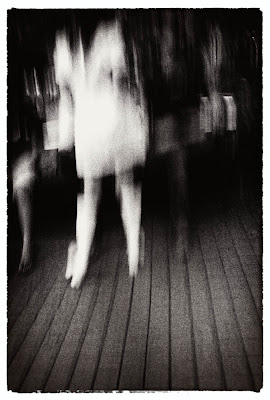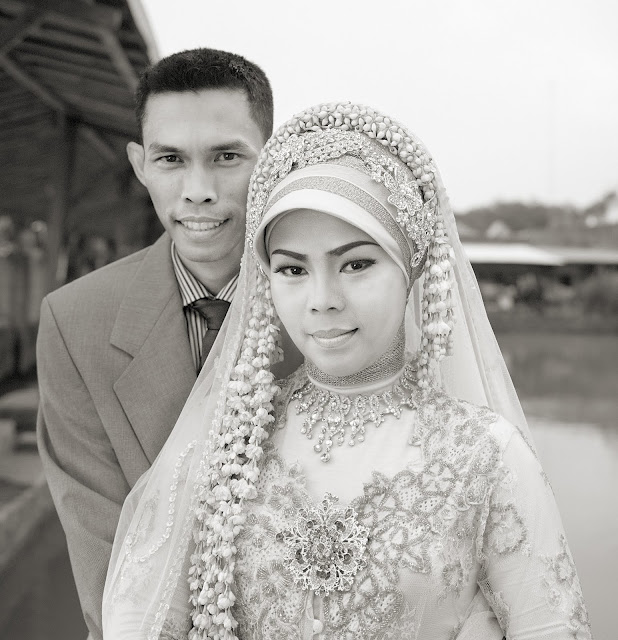Macau, along with Hong Kong, one of the two special administrative regions of China. It lies on the western side of the Pearl River Delta, bordering Guangdong province to the north and facing the South China Sea to the east and south. Macau was a Portuguese colony and both the first and last European colony in China. Portuguese traders first settled in Macau in the 16th century and subsequently administered the region until the handover on 20 December 1999.
Looking back to Macau Island from Taipa (Canon G9, 12 shots stitched)
Sal Van Bridge on the left, Macau-Taipa Bridge on the right, and the Friendship Bridge faintly visible beyond that. Its about 2.2 kilometers from Taipa to Macau, although the Friendship Bridge is actually 4.4 kilometers long.
I'll begin by stating for the record,
"I find Macau to be a butt ugly city". It has become a gambling mecca with more than 30 casinos on just under 50 square kilometers
(broken down as 29.5 Macau; 6.8 Taipa; 7.6 Coloane; Cotai 5.8) and this has led to the construction of bigger and bigger and more glitzy establishments at the expense of local culture and history.
Above is Sands Casino, although its pretty reminiscent of all the larger casinos. Row after row of black jack, roulette, big & small and baccarat tables. As a caveat, I spent 10 years of my life working in casinos on the gaming floor so I come to this with an existing bad taste in my mouth. I've seen what it does to people and the Chinese seemed to be inflicted with a gambling gene which just exacerbates the problems.
So thats my small rant... I actually end up in Macau reasonably frequently - maybe once or twice a year. Work has its regional sales conference there and my sister lives there. This year (2010) back in October it was 3 days held up at the Venetian and I loathed the place from the second I stepped foot into it, which is more of an insight into me than the place itself. Its majestic, massive, pretentious and full of gamblers. I think it must have taken me all of 20 minutes to check-in, drop off my luggage and hit the streets with the camera.
From Singapore, I'd rather fly direct but its only the budget carriers that ply that route and they're notorious for canceling flights. So its usually fly into Hong Kong and take the ferry for one hour down to Macau. The ferry trip is fine but it just tends to add an additional 3 hours to any direct flight.
Residential areas tend to be masses of high density housing, much of which has seen better days. These are riddled with narrow lane ways that are often bustling with life. However, like many of their Hong Kong brethren, people here are not necessarily happy to see cameras around.
Although I've never been inside a local apartment in Macau, from the external appearance I would hazard a guess that they would be very similar to small and aging apartments that exist in many areas of Hong Kong.
Macau bases itself on tourism these days, and the primary attraction is gambling. However, when people do venture out, many head to an up market area called San Malo. this area has wide paved walking areas void of traffic with many of the shops you would find in any high street -
Giordano, Body Shop, Starbucks.
Personally, Im a people photographer -
call it street, documentary, travel or what ever works for you - but as such I find it almost impossible to take a straight shot of an environment without the dominant subject being people. Its the human side of Asia that fascinates me.
Continuing to wander around in the San Malo area will eventually lead to the Ruins of St Pauls. I can understand why they are a tourist attraction but is nothing more than the front facade of a once church. The first time I was ever here was back in 1979 when my Dad took me to Hong Kong for a holiday. Macau was a day trip and the only aspect I even remember is visiting the gambling halls of the original Lisboa casino during the afternoon and being amazed at its size; and a vague recollection of these ruins.
The above shot was the first time I came to San Malo with my sister. But I still had no desire to really photograph the ruins for their own sake. Looking for something to anchor the foreground, the gardeners, largely ignored but everyone else, seemed more important to my vision on the day. On a more recent trip to Macau, I was looking to shoot a more moody version of the ruins but struggled to find any vantage point that impressed me. This was the best I came up with...
As I was standing around just watching the crowd, I was amused -
as I so often am - by the way many other photograph these days, especially when it comes to using mobile phone cameras. It almost feels as if people take photos these days as a proof point to say
"see, I was there!". [edit]
...funny, I only just realised weeks later that this girl is actually photographing herself and not the ruins...
This is all on Macau, the other two islands of Taipa and Coloane are very different - apart from the ubiquitous casinos. Taipa is very quiet, small and predominantly residential. Below is a view from my niece's bedroom widow of the densely populated high-rise that are common in Taipa.
Taipa is some 2.4 kilometers across from Macau across, what is called, the Bay of Pak On. Of the three connecting bridges, you can only walk on the middle one -
Macau-Taipa Bridge. My wife and I lost all sanity on one visit and actually walked across. It was the middle of winter, cold and foggy which made visiting Starbucks on the far side all the more enjoyable...
Further south of Taipa is Coloane which is is now connected by land-fill called the Cotai Strip. The most prominent landmark in the Cotai Strip is the Venetian Hotel/Casino. I ended up staying here back in October for the corporate regional sales conference. Hated the layout ...they force you to walk long distances through the casino itself to get from point to point. Almost a 15 minute walk from check-in to my room.
But I must admit that the Venetian shopping malls with their replciated venice canals and painted vanilla skies are impressive. It always feels like you are there outside at dusk.
Coloane is rather different with useable beach and mountainous terrain. I've been to the beaches in both summer and winter and although the number of people is dramatically different, there are always people swimming - and winter is cold. Below, a local fishing off a beach in Coloane...
To other noteable places on Coloane are Tian Hou Palace and the statue of A-Ma on Mountain Dep Sek Tong. The statue is part of a story that represents the past history of Macau as a fishing village, heavily dependent on the sea. In front of this statue is an inscription that I photographed with my phone and later transcribed...
A-Ma patroness of seamen, fishermen and merchants is a Taoist goddess. A-Ma, literally meaning "mother" in Chinese, is also known as Tin Hou (Empress of Heaven), Ma-Chau and Neong Ma. Her name is similar to that of Macao.
A-MA was born to the Lin fishing family in Fujian province in the year AD 980. she was a gentle beautiful maiden who demonstrated admirable virtues and sacred powers from childhood. She dedicated her life to guiding the voyages of sailors and merchants, even rescuing them from stormy waters. She has been worshipped for centuries and even nowadays, her kind deeds are remembered in the provinces of Fujian and Guangdong.
Legend relates that A-Ma also protected fishermen and merchants who sailed to Macau. In gratitude for her protection from the perils of the sea, a temple was erected n her honour on Barra Hill and she was worshipped here long before the Portuguese arrived. When the Portuguese settled here, they called the land "Macau" meaning "The port of A-Ma"
Besides historical and mythical reasons, belief in A-Ma plays a very important role during Chinese New Year. Crowds of followers flock to the temple to thank A-Ma for her protection and to pray for a peaceful life. The charisma of this goddess has bolstered the confidence of those living here to introduce developments in this united community. Macau has thus served as a safe shelter for people living here since it opened as a port.
This crucial time, as Macau reverts to Chinese sovereignty is most opportune for erecting the world's highest statue of A-Ma on the summit of Coloane's highest mountain.
The statue weighs a thousand tons and stands 19.99 metres high. It is fashioned from white jade from Fangshang in Beijing. One hundred and twenty sculptors worked for eight months to produce it.
Cultural Institute of Macau, 28th of October 1998
Across Asia I tend to get a little "templed out". They can become a bit like 7-11s, meaning there seems to be a temple of some kind on every street corner. The result is that I tend not to shoot temples so much for their architecture. Below is one of the few shots I took at Tian Hou Palace. This intricate art work is on the steps leading to its entrance...

The last time I visited, which was for work, I had allowed myself an afternoon to shoot. I used Kodak Ektar 100 and was looking for a less common view of Macau. As a C41 colour film, Ektar is fantastic (and a real bitch). As a digression, the first time I used it was back in April 2010 while in Tokyo, while testing a newly acquired Voigtlander 50mm f/1.1 Nokton. As I typically do with C41 films, I rated it at half speed - ISO 50 - well I found out the with a full stop of over exposure the colour shift and cross-over is so bad that its almost impossible to correct even in post processing. This time I shot it at box speed but even then colour correction becomes a real art, although easier.

A search of images on Flickr with the tags of "macau" and "macao" provided no more than the typical tourist shots - nothing remotely impressive as an area to investigate. So I went to my next option - Google maps! Google maps can be very revealing in satellite view in identifying place of interest to shoot. From the above image I could see ships - and docks are always interesting places - that appeared potentially accessible on the west side of Macau on the narrow water way between Macau and mainland China. Below are are few shots from getting myself onto the docks and being generally nosey...
As the day started closing I began to wander back into the city centre area happening across some more interesting opportunities along the way. This was some guy putting final touches on a Chinese casket - something both interesting and different.
This post has become long enough, but needless to say when going to new places to shoot Google Maps can be a great help... But as one final image, as the daylight was closing on using a 100 speed film, I managed to achieve, what I would consider, one of my best shots of the 2010 - Leica 35 Asph Summilux v1 at f/1.4. Best for me in terms of composition, content, simplicity, colour and depth of field, but as I mentioned earlier, colour correction on Ektar can be tough work and this one was no exception...























































